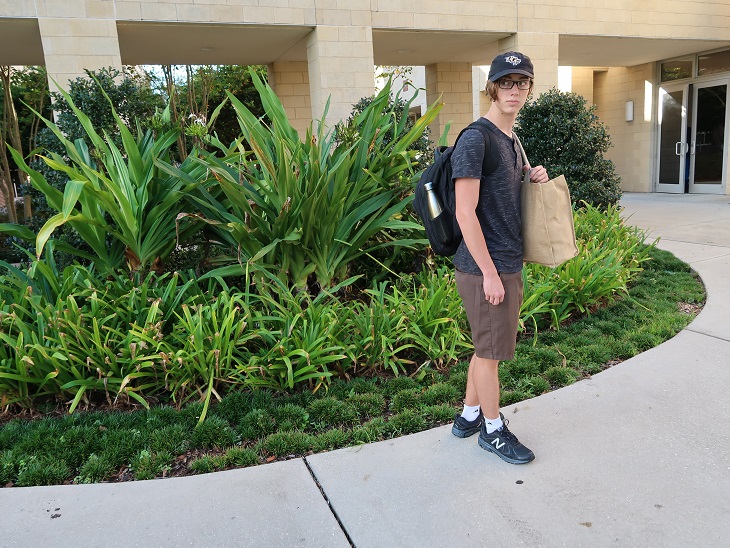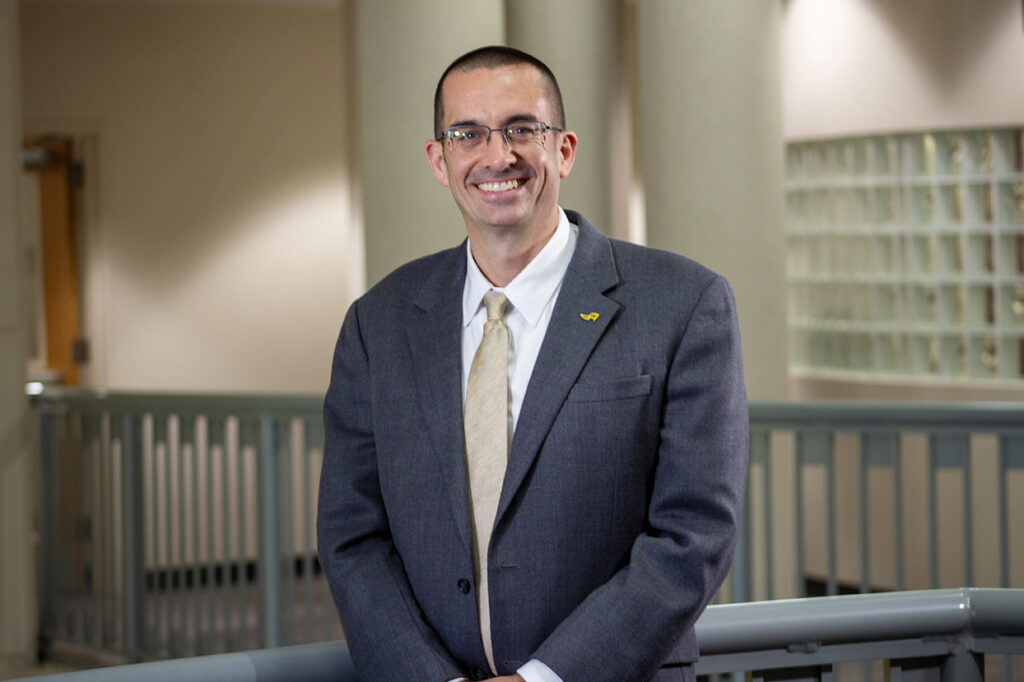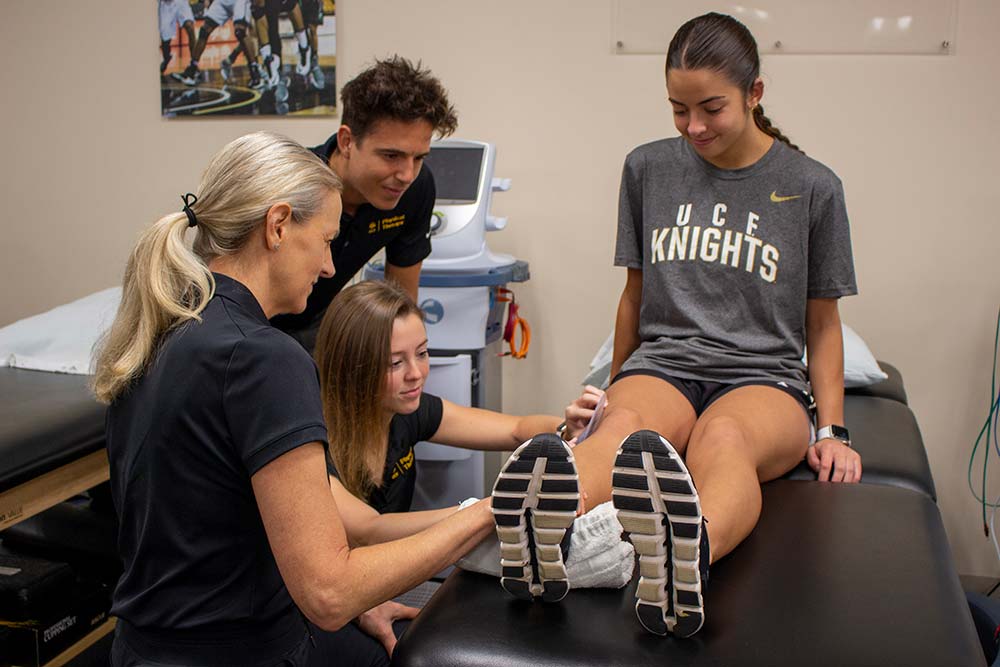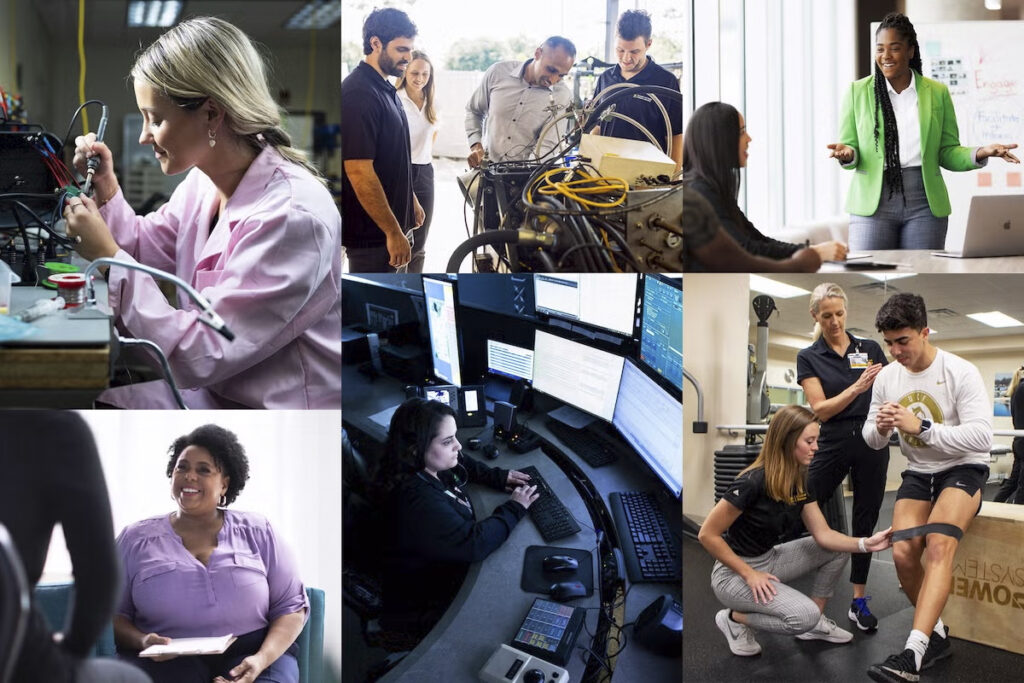
The American Chronic Pain Association dubs September as Pain Awareness Month. While habits like slouching, knuckle-cracking and constant phone usage might not affect students’ bodies today, College of Health Professions and Sciences associate professor William Hanney says over time, these habits may have an effect on your body.
Hanney provides some suggestions for taking care of your back, neck and joints.
Weighty Issues
“When you’re 20 years old, you can do whatever you want, all day long,” Hanney says. “It’s not until you get to be about 45 that things start to catch up with you.”
Cole Preble is a civil engineering student and on this particular day, he was carrying a stuffed backpack and a second bag.
The backpack, which Preble estimated weighed at least 25 pounds, had four notebooks, three folders, graph paper, a huge book, umbrella, various writing implements, calculator and a reusable water bottle. His tote bag carried a change of clothes so that he could go straight to work after class.
“There is no alternative,” Preble says, when asked why he carried such a heavy backpack. But, so far, the 19-year-old has not experienced any neck or back pain.
“A heavy backpack isn’t necessarily bad,” Hanney says. “What’s bad is if you keep it on the same shoulder for weeks or months. Our bodies are designed to adapt to external forces.”
Hanney recommends alternating your backpack from shoulder to shoulder, and to use both straps occasionally.
“And of course, if you have pain at any time when you’re carrying your backpack, that is a clear sign that you need to take a break.”
Pain is nature’s way of telling us we shouldn’t do something, Hanney adds.
“For now, the best thing for [students] to do is stay active, get enough sleep, and don’t ignore what your body is trying to tell you through pain.”
Taylor Turberville, a mechanical engineering student, and Andrea Tomancik, an information technology student, had similar items in their backpacks, which they usually carry on their backs, using two straps.
On this day, Tomancik is shouldering a laptop, calculator, notebook and pens. “It could be a lot heavier,” she says, laughing.
Turberville says she hasn’t experienced any neck or back pain; Tomancik said she gets back pain occasionally from the way she sits. “I’m usually hunched over, writing,” she said.
Text Neck
There has been some literature about a phenomenon colloquially called “text neck,” Hanney says. As the name suggests, text neck occurs when our necks are craned — unnaturally — in a 45-degree angle over our smart phones.
“The head is meant to stay in an upright position,” Hanney says. “If you feel the muscles and tendons in your neck, they are supple when your head is upright. As you bend and twist your neck — while looking at your cellphone or any other activity — those muscles become rigid. The more rigid they are, the harder it will be to move your neck.”
It remains to be seen what neck and back problems, if any, this generation will have later in life because of their phone usage, Hanney says. “Look up from your phone every once in a while to keep your neck healthy.”
“Look up from your phone every once in a while to keep your neck healthy.”
Hanney also suggest that students use a book stand when they are seated. Instead of having a book flat on the table, the stand elevates the book so that the reader can more easily read without craning the neck.
Belly Dancing for Pain
Hanney became interested in neck and back pain when he first became a physical therapist. Some of his colleagues did not like treating clients with those specific issues because it can be difficult to see improvement, and the origin of the pain can be difficult to pinpoint, making the therapy difficult to prescribe.
Hanney is a strong advocate of exercise-based interventions for pain. Exercise in general is a good prescription for everybody, no matter what your age.
“Our bodies were meant to move,” he says.
But, he adds, just because exercise is prescribed, it does not mean that the client will be compliant.
So, a few years ago, as Hanney was in search of options to make exercise more appealing and spoke with one of his students, Tabitha Castrillón, who was a belly dancer at Epcot.
Hanney and Castrillón found that belly dancers utilize some of the same trunk and pelvis muscles that have been found to alleviate chronic low back pain (cLBP). The results suggested that a belly dance program may positively influence pain and function in women with cLBP.
“Belly dancing was no better than the other exercises we tried,” Hanney says, “But it might get people to exercise and improve their perception of pain.”
Talk Back to Pain
In a National Institutes of Health (NIH) study in 2015, data showed that as many as 66 percent of the population over the age of 30 have common degenerative spine conditions, yet are asymptomatic.
Clients who have been experiencing back and neck pain, and have had a recent diagnosis of a bulging disc, often fret over having a pain-free life again, Hanney says. But when he suggests that they may have always had a bulging disc, it helps change their perception of treating their pain.
The School of Kinesiology and Physical Therapy is developing a new course on pain science, according to Carey Rothschild, a physical therapist and associate lecturer.
There are lots of different factors associated with pain. Imagine, Rothschild said, “You’re crossing the highway and sprain your ankle, and experience immediate intense pain. But that pain is momentarily forgotten as you see a bus bearing down on you, and you sprint to safety, with the pain momentarily forgotten.”
The reason that pain may be forgotten in the moment, Rothschild said, is attributed to the fact that the brain perceives the bus as a greater threat than an ankle injury.
Hanney suggests that students keep their back and neck healthy by being active.
“People who are fit are less likely to become injured,” Hanney says. “Pay attention to your body. A lot of people ignore symptoms, and then become more resistant to treatment.”
“I’m really not too worried about our students having neck and back pain now,” Hanney says. “That might change as they get older, but for now, the best thing for them to do is stay active, get enough sleep, and don’t ignore what your body is trying to tell you through pain.”







